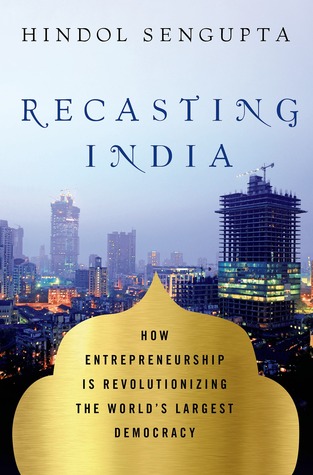Book Review

Browsing the politics and business shelves of any bookstore in Delhi, one can’t help but notice such titles as “Reimagining India: Unlocking the Potential of Asia’s Next Superpower,” “India Calling: An Intimate Portrait of a Nation’s Remaking,” and a number of other variations on the basic theme of Reinventing India. It becomes immediately clear to even the casual observer that an all-encompassing and very animated debate is going on in this country about the huge social, economic and political transformations it is experiencing as it undergoes a complex and at times controversial process of modernization and liberalization.
The latest addition to this ever growing genre is a book by Fortune India Editor-at-Large Hindol Sengupta titled “Recasting India: How Entrepreneurship Is Revolutionizing the World’s Largest Democracy” [Palgrave Macmillan Trade, November 18, 2014]. The gist of Sengupta’s argument is that, contrary to popular belief, the real driver of India’s growth, and the true strength of its burgeoning free-market economy, is not big business—not the massive conglomerates belonging to the country’s cosmopolitan, jetsetting elite, with such names as Tata, Ambani and Oberoi. “India is brimming with the aspiration of a billion entrepreneurial minds,” writes the author, “What former prime minister Manmohan Singh once referred to as the ‘animal spirits’ of the economy.”
In “Recasting India”, Sengupta finds the most unlikely of them—women entrepreneurs, dalit (or untouchables) entrepreneurs—and visits them all over the country—from Kashmir to Tamil Nadu. His, then, is a journey through “pockets of incredible enterprise and dexterity;” a book about the “extraordinary enterprise of ordinary people” succeeding against all odds. Some of Sengupta’s encounters are more memorable than others. For example, one is struck by the determined creativity of Arunachalam Muruganantham, the self-described “pervert” pad maker. A 49-year old man from the southern city of Coimbatore and a former mechanic, Muruganantham is the inventor of a machine that produces cheap sanitary napkins for India’s 355 million menstruating women, of whom only 12% used pads in 2011. In the course of doing research on the topic, which remains taboo in much of the country, Muruganantham antagonized all of the women around him, including those in his family, and was exiled from his village. At one point, for lack of a better alternative, he “made a contraption that had a football bladder filled with goat’s blood and connected it to a sanitary napkin that he wore.” Then, to test a pad’s absorbency, he began cycling while wearing the device. So far, Muruganantham’s machine has been sold in over 1300 locations in India and worldwide, from the Philippines to Mozambique.
By capturing the entrepreneurial ambition and dynamism that is found today across the country, “Recasting India” attempts to expand on the notion of the fortune at the Bottom of the Pyramid (BOP), first introduced in 2002 by economists CK Prahalad and Stuart Hart and according to which the poor represent a vast untapped market for businesses and the next frontier for growth. Now that Indian villagers finally enjoy some modicum of disposable income, they have become consumers in their own right. In Sengupta’s telling, locally born and bred entrepreneurs are eager and ready to cater to their every need and are much better positioned to do so, more nimble and knowledgeable of the communities in question, than major multinationals.
Now, if only the government would get out of the way. This is, for Sengupta, the missing ingredient in today’s India. As the guardian of a system that too often verges on the worst kind of nepotism and crony capitalism—the same system that favors mammoth companies to the detriment of smaller firms—“for too long the state has interfered and impeded the natural entrepreneurial prowess in India.” This doesn’t mean that the state doesn’t have a role to play. According to the author it does, “in ensuring justice, equity and democracy” for everybody, in leveling the playing field so that smart, hard-working people from all walks of life can be freed to dream their own “Indian dream.”



